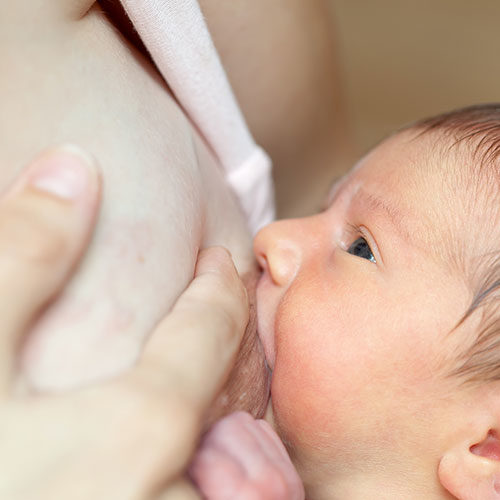My baby nurses only from one side, what can I do?
Breast preference is a normal and not so uncommon phenomenon that babies show. Similarly, a mother might notice that one of her breasts is making more milk than the other. This is common too. Just how there are differences in our two hands, legs, eyes; there is quite a plausible difference in two breasts too. In size as well as in their milk-making/storing capacity and let-down reflex. This asymmetry is common among humans which can sometimes be barely noticeable, whereas sometimes can be evident.
Supply difference (evident) can also be caused by hypoplasia (less glandular development) of one breast.This can be best assessed by a Lactation Consultant only
Causes of Breast Preference :
Babies reject one of the breasts due to a variety of reasons.
- Sometimes newborns reject a particular breast due to a birth injury that might have gotten unnoticed at the time of the birth. The nursing position in that particular breast could be painful for the baby, hence, the rejection.
- A baby may reject a breast because of engorgement.
- If the nipple of that particular breast is flat/inverted.
- If the let down is too fast.
- If the let down is too slow.
- If the supply is low in that breast.
- Ear infection in one ear may cause the baby to be uncomfortable while nursing from a particular side which may result in rejection of that breast.
- Sometimes an immunization spot on a particular side may be hurting the baby, causing her to reject the breast that may require her to position herself uncomfortably.
- A breast infection can make the milk taste different, leading the baby to refuse that breast.
Causes of Evident Supply difference in two breasts (Lopsided):
Little supply differences in two breasts are very common and normal. However, evident differences in supply may be due to one or more of the following reasons.
- A previous breast surgery.
- A previous breast injury.
- The baby has taken preference to one of the breasts and is ignoring the other one.
- Mother prefers to nurse on a particular breast more.
Other reasons why a mother chooses to nurse from one side:
- Recurrent plugged ducts and/or mastitis in one breast might make a mother averse to nurse from that breast. In some cases, the mother might decide to wean the baby off that particular breast.
- Some physical problems which may make it difficult for the mother to nurse from a particular breast. E.g. amputation of an arm.
How to help and assist the baby to nurse from the less preferred side?
There are certain techniques that may help in persuading the baby to latch on and nurse from the less preferred side. Some of them are listed below.
- Offer the less preferred side when the baby is very sleepy or is just waking up.
- Trial and error in terms of various nursing positions can find out a particular position that might work!
- Nursing the baby in a football position while nursing from the less preferred side. So, the baby’s position remains the same. This can trick the baby into believing that she is latched onto the preferred breast.
- If the baby is rejecting a breast due to low supply, working on the supply (by artificially stimulating the breast more often) could help the baby accept it.
- If the reason for rejection is a fast letdown, expressing some milk before nursing and nursing in the laid back position can help. More techniques to deal with fast letdown and oversupply can be found here.
- If the reason for rejection is slow letdown, breast compressions while nursing can be a great help.
- Offering the less preferred side first when the baby is hungry can be helpful as the baby is hungry and nurses more vigorously which in turn helps in increasing the supply in the breast.
- Sometimes, the baby might get fussy when offered the less preferred side first. In that case, offering the preferred side first and then sliding the baby onto the less preferred side in football position once letdown occurs may work.
- Offering the less preferred side while walking, rocking, swaying etc.
- Seek help from a lactation professional to find out the reason for breast rejection and then work on the probable solution.
- If nothing works, offering expressed breast milk (EBM) from the rejected side remains an option.
Nursing from only one side :
If all attempts of nursing evenly from both the breasts persistently fail, or if a mother decides to nurse only from one breast due to some problem or any other reason; she can definitely do so and still meet her baby’s needs, if the baby is nursed on demand. However, it is important to check that the baby is getting enough.
If the mother is not even expressing milk from the rejected side, the milk supply diminishes. This could make her look lopsided. The breast which is making milk can look much larger than the one from which the baby has been weaned. In most cases, others cannot really see the difference. But if the mother is feeling conscious, she can use breast pads on the smaller breast to even out the size. Once the baby has completely weaned, breasts go back to their original (more equal) sizes.
References :
https://kellymom.com/bf/got-milk/lopsided/
https://www.breastfeeding.asn.au/bfinfo/one-sided-breastfeeding#
https://www.babycenter.com/baby/breastfeeding/breast-preference-nursing-on-one-breast-only_8492

Wish to speak with a member of our team who is a certified lactation professional and also an experienced breastfeeding mother, click on this link.
Medical Advice Disclaimer
THIS WEBSITE DOES NOT PROVIDE MEDICAL ADVICE.
The information, including but not limited to, text, graphics, images and other material contained on this website are for informational purposes only. No material on this site is intended to be a substitute for professional medical advice, diagnosis or treatment. Always seek the advice of your physician or other qualified health care provider with any questions you may have regarding a medical condition or treatment before undertaking a new health care regimen, and never disregard professional medical advice or delay in seeking it because of something you have read on this website.
Disclaimer
We understand and acknowledge that parents and babies can be of various genders on a spectrum of LGBTQI+. Families come in diverse flavours. However, in our articles, for the sake of simplicity and convenience, we will be referring to the breastfeeding parent as the mother and using the female pronouns- ‘she’ and ‘her’ for babies. Babies can be nourished and nurtured in different ways and while we have used the terms breastfeeding and nursing, we recognize that parents can opt to chest feed or finger feed.
We don’t have conflicts of interest and declare, and we are compliant with the WHO code of marketing of breastmilk substitutes and the IMS act.
In case you find any information on this website that needs to be updated, please write to us at info@bsim.org.in






